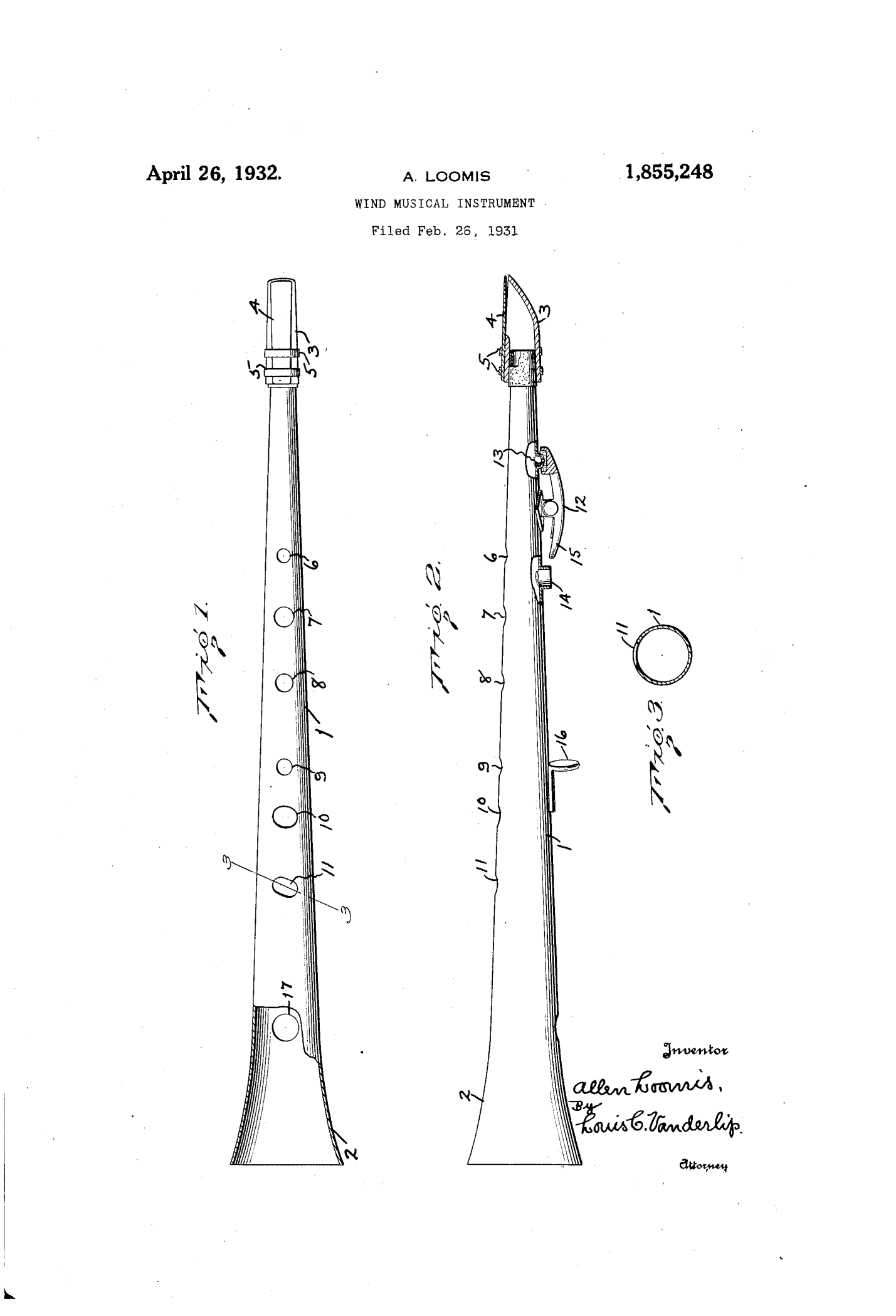Source: eBay.com
Although it has been written in numerous places (including here previously) that the Conn Clar-O-Sax was not built as a toy, but rather as a musical instrument, I recently came across the patent for this instrument. Although the patent does not expressly state what the Clar-O-Sax’s purpose was, it was clearly designed with children in mind. Here is how the Clar-O-Sax’s inventor, Allen Loomis, described the how and why of the tone hole design:
Another important feature of the instrument pertains to the formation of the tone holes 10 and 11 which may be elongated transversely of the instrument axis, or somewhat oval in formation, and which are of greater area than the remaining tone openings, the increased area of the tone openings 10 and 11 being gained by transverse oval or elongated formation. Inasmuch as my improved saxophone may be extensively used by children [emphasis added] whose finger spread or reach is less than that of the average adult person, the openings 10 and 11, which are elongated as heretofore stated, are disposed at acute angle in relation to the instrument axis, as determined from one side of the instrument, and at an obtuse angle as determined when viewed from the opposite side-of the instrument.
Source: Google Patents (typos corrected using original patent document.)
According to the original patent application, these are the key features of the the Clar-O-Sax:
• A saxophone-type instrument.
• Uses a single reed that is held in place on the mouthpiece with a ligature.
• Keyless – except for an octave key.
• Conical, straight, thin metal body that ends with a metal bell.
• Six tone holes, in a series, on the front of body tube, which provide a scale like those of a fife or ancient flute.
• Two of the six tone holes are transversely elongated to allow a child with a limited reach to play the instrument.
• Octave key operated by a spring.
• Elevated thumb-controlled 7th tone hole adjacent to octave key, which doubles as a left thumb rest, and allows production of the G major scale in two octaves.
• Thumb rest for right thumb
• A permanently-open tone hole in the back of the bell
What the Clar-O-Sax looks like in real life
This particular instrument below turned up on eBay in March 2010. As you can see, this one has had a particularly hard life. The only thing perhaps more shocking than its condition was what it sold for. The winning bidder paid $416.00 for this vintage instrument.
Source: eBay.com
In the fall of 2010 another Clar-O-Sax popped up on eBay. This one had not been beaten up or even abused. The owner knew something about the little instrument, since he actually played it. This is what he wrote about the Clar-O-Sax he was selling:
Here is an original 1929 Conn, made in Elkhart, Indiana. These are extremely rare and this one is in original condition. Comes with the original metal mouthpiece and a Selmer C*… There are no ligatures included. Plays in the key of G. Has a foam case.
Source: eBay.com
Interesting that the one above is in the key of G. I wonder if they all were? So far Internet searches have not turned up any information about the Clar-O-Sax. I have however been able to dig up an old gallery from the original Saxpics site that USA Horn has not linked to. This gallery features a rather minty Clar-O-Sax complete with the original box, and instruction sheet.
In May 2014 yet another Clar-O-Sax appeared for sale on eBay. It appeared in very lovely condition, and sold for the (IMHO anyway) crazy-ass price of $400.00! Judge for yourself if you would spend that kind of money for this toy instrument…
Source: lovejunk112 on eBay.com
A Clar-O-Sax mouthpiece?
In August 2011 a Clar-O-Sax mouthpiece popped up on eBay. The photos and information provided by the seller add an interesting piece of information to the history of this mysterious little instrument.
Source: heidisaxo
An extremely rare C G CONN metal Clar-O-Sax, or sometimes E flat sopranino sax, mouthpiece! This is a very early Conn mouthpiece. It is only 2 inches long and the inside shank measures only .469 inches. [It] has a very, very small chamber–you can see the comparison next to my Claude Lakey Bb sop mouthpiece in size… Its markings are on the end of shank. Reads: CG CONN LTD Elkhart Ind. mouthpiece is cast out of what looks like a version of solid nickel silver or German silver, similar to the old Goldbeck pieces. It is NOT plated.
Source: heidisaxo
Source: heidisaxo
FWIW, I find it difficult to believe that Conn would put an expensive mouthpiece like this into what is essentially a toy. I suspect that this really is a sopranino mouthpiece. Buy hey, I could be wrong.
















































You must be logged in to post a comment.